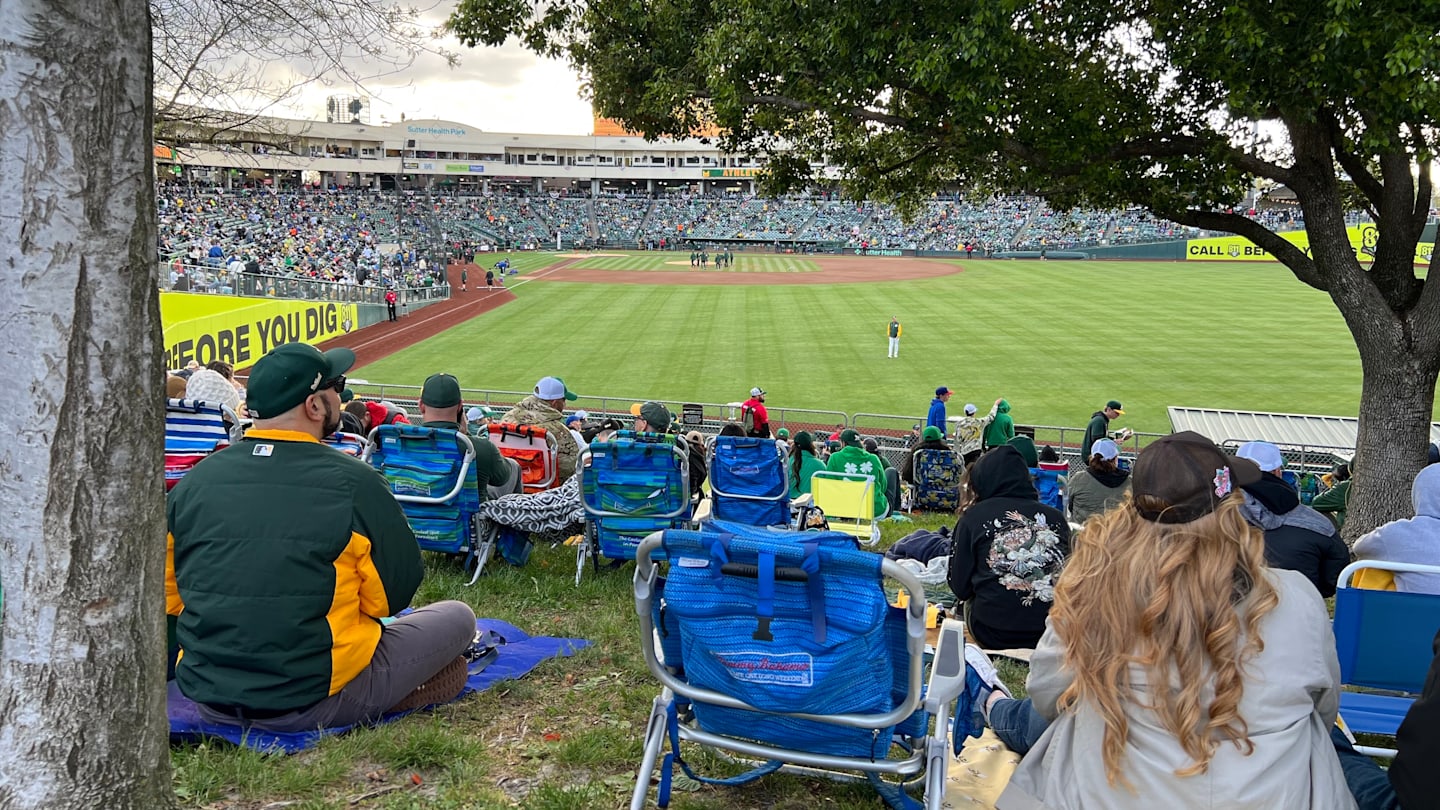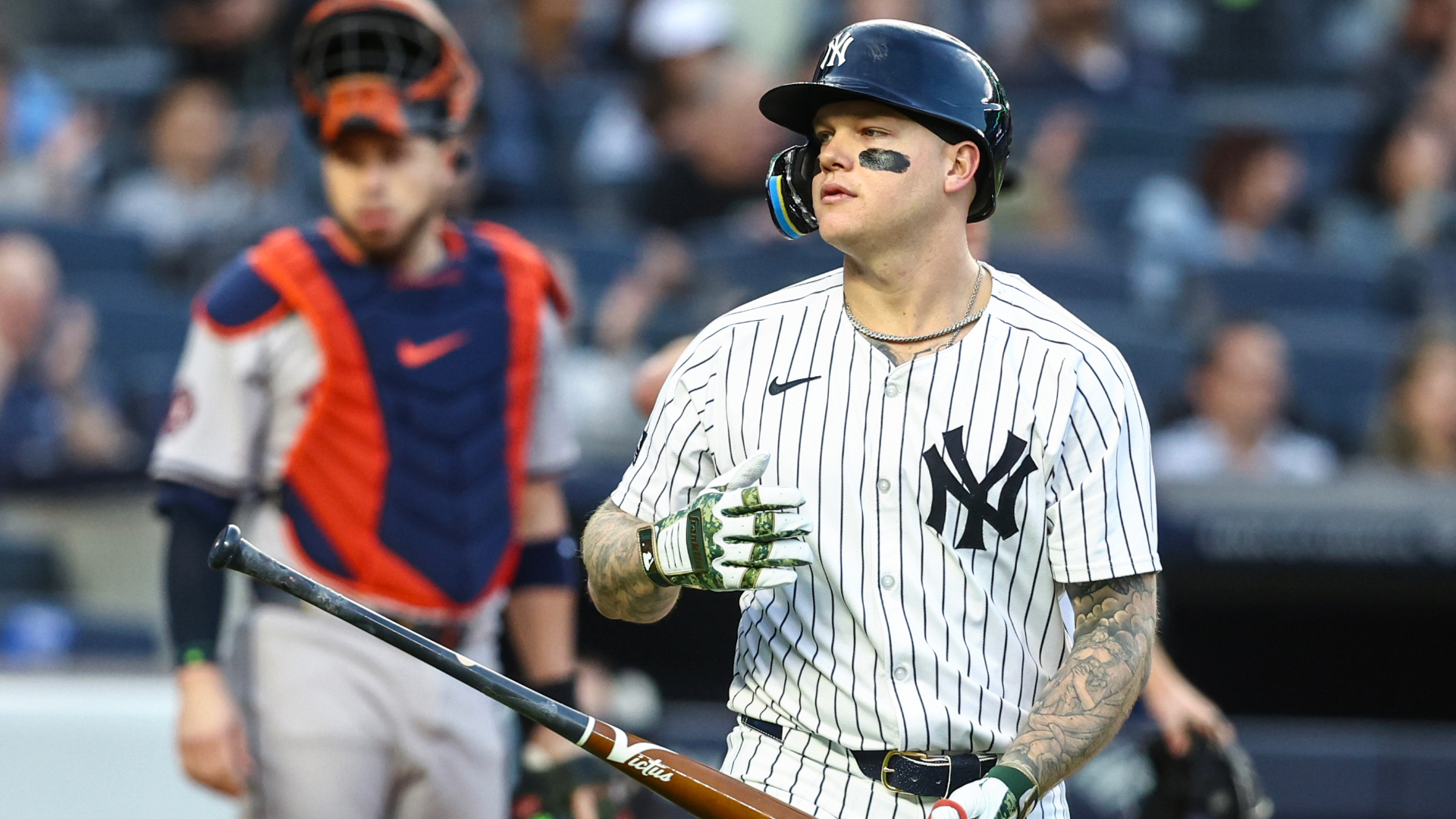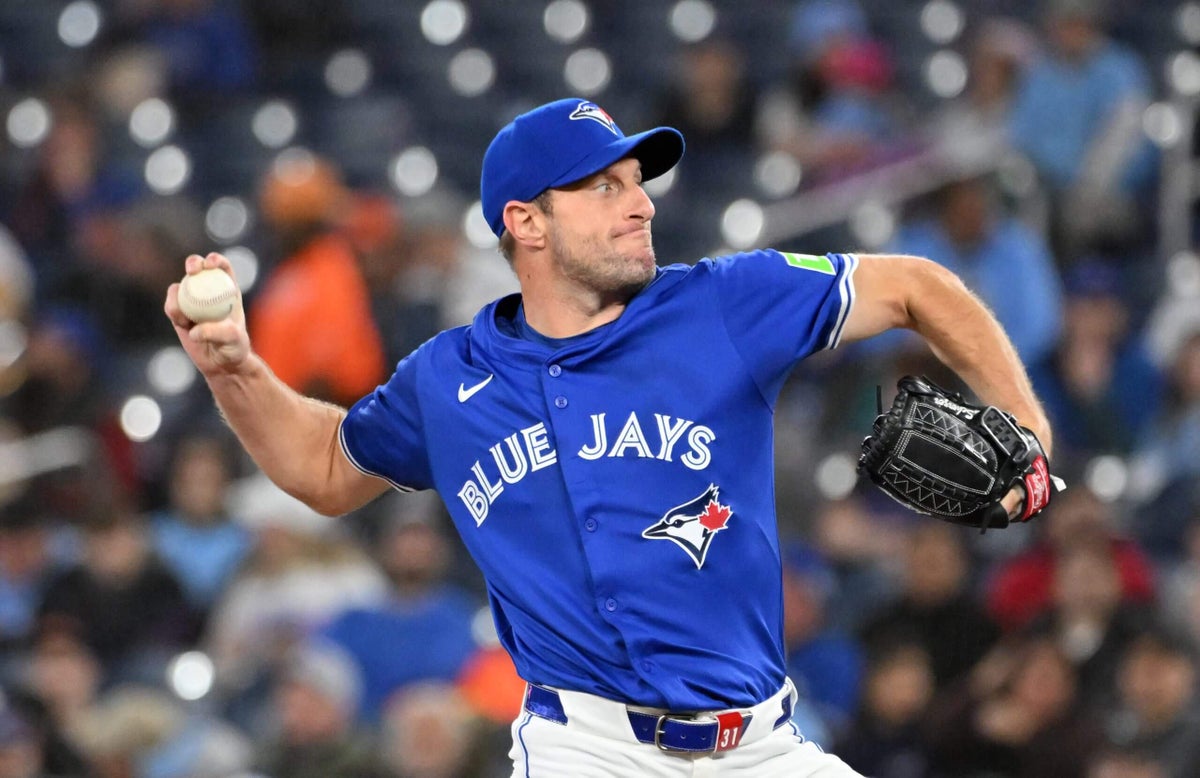Anyone arriving to this West Sacramento neighborhood on Monday evening, both a regular Monday and unlike any other Monday here before, must have felt, among so many swirling emotions and opinions and debates, predominantly … confused?
Sure, at least 14,000-some-odd souls were headed to Sutter Health Park. And not for a minor league baseball game—which, under more typical circumstances, is precisely what would have unfolded. Not Monday. Oh, no. Those fortunate enough to score seats were headed to a Major League Baseball game. In Sacramento. Make that West Sacramento. The A’s new home. Er, temporary home. Well, O.K., more like their layover stadium on a lengthy relocation trip with a very long connection between the city they have already departed (Oakland, duh) and the city where they will reside (Las Vegas).
And yet, in the neighborhood near the park, only 90 minutes before the first pitch of the A’s “home” opener, the streets nearby were not choked with, well, anything or anyone. No traffic, let alone anything resembling a “jam.” Most parking lots sat empty. The rainstorm expected earlier in the day had not materialized after a morning downpour.
My Uber driver compared this Monday to any other Monday in this neighborhood, after revealing he hadn’t followed any sports since the COVID-19 pandemic.
“A cakewalk right here,” he says. “You sure there’s a game?”
Oh, yeah. On the official MLB schedule. Promise. Sold out. Secondary ticket market going bonkers, relative to normal. Just no … fans. Nobody outside the new apartment buildings, many still under construction. Nobody on the path ahead, the one pointed toward a golden overpass, the Tower Bridge which connects this neighborhood to downtown.
This wasn’t exactly a tumbleweeds scenario. It wasn’t exactly not a tumbleweeds scenario, either.
Was that a scoreboard glimmering with images and statistics in the near distance? A faint hint of bass, not yet thumping, in the same general direction?
Then: Street art, sprayed on a slab of concrete, with green dots and a long, green swirl—not unlike A’s colors, amirite?—and an apt phrase painted in pink. It read: A West Sac Story.
Now we’re getting somewhere.
All sorts of signs peppered the Cabaldon Parkway, announcing the neighborhood that would soon host a bona fide MLB game. Right? The Bridge District. For a “home” that resembled more of a ghost town, this wasn’t a clue so much as a metaphor. That will be the juxtaposition in the next three seasons for a proud baseball franchise replete with significant players and eras and moments throughout the vast majority of MLB’s history, now in its 154th season.
Winds whipped those Bridge District banners. Nobody lingered at the intersection where visitors turn and head toward the main entrance. One guy—one!—stood at some gated-off entry that didn’t look accessible to anyone at all. One stadium worker, passing by this one guy, yelled out, “Love the A’s hat, baby! He’s VIP! Look at that face! It’s not pretty but it’s his!”
The park’s fences soon rounded into view. Then the park itself. And there it was, the next era of Athletics baseball, among so, so many eras of Athletics baseball, neatly summarized in empty streets, district banners and an innocuous comment. This park may not be pretty, at least in the traditional MLB park sense, but it’s theirs. These seasons will not be like previous A’s seasons. They will be, wait for it, bridge years for a franchise that can stay put, for years and for decades and for more than half-a-century in Oakland, and yet, this same franchise never stays in one place, not permanently. Not yet.
A West Sac Story, then, began in earnest on Monday night.
Inside Sutter Health Park was not like outside Sutter Health Park. Not even a little bit. Inside bustled. Inside crowded. Inside teemed. Inside was TV crew after TV crew filming stand-ups. Inside was a concert playing near the entrance before the game started … to an audience of five. Inside were corridors so packed that “jam” absolutely applied to the crowds. Inside presented fans clad in merchandise that would have seemed in conflict—Oakland A’s gear, just A’s gear, Eckersley and Henderson and Mr. October gear, San Francisco Giants gear, Cubs gear and River Cats gear—if not for the circumstances. But the River Cats also call this their “home” stadium—they knew it as Raley Field before this season—and they feed into the MLB’s Giants, hence the mishmash of merch wading through the crowds.
I spoke to a handful of fans on a pre-game walk throughout the concourse. Even with the inching that owed to corridors that weren’t constructed for this many bodies to pass through at one time, from one end to the other only took 10 minutes.
Underneath the Legacy Club, an indoor space with outdoor seating high above the field, with views of the baseball and downtown …
Past the beer garden near left field …
Past the retired numbers now painted on the corridor wall … 27 (Catfish Hunter) … two 34s (Rollie Fingers, Dave Stewart) … 43 (Dennis Eckersley) … 24 (Rickey Henderson) … and 9 (Reggie Jackson).
Past the Cadillac Diner …
Past the Coop and Kennel Pub, which is themed like an Irish bar in midtown Manhattan, minus the bar; making it more like any other concession stand in any other non-major stadium, only with semi-Irish food and stereotypically Irish drinks and a way cooler, if not modestly misleading name …
Past the in-stands “porch” where beer drinking is encouraged …
Past the smokehouse …
Past the vineyard (anyone else sensing a theme?) …
Past the “Down on the Farm” area that’s primarily for children, with its Wiffle ball field, Tower Bridge replica, splash zone and Dingerville, ostensibly a town that’s not really a town, just like this “home” isn’t really anything beyond temporary shelter for the A’s. Dingerville is ostensibly run by children, made from, of course, repurposed shipping containers. As the father of two young kids, I’m going to take ballpark officials at their word on that.
The tour proved charming, professional sports without the gross parts but also minus the convenience of things like available bathrooms, a line that doesn’t snake, more typical comforts and personal space.
All for this, for history on Monday night: The Athletics—no city preface, nor multiple versions of the journalism entity—vs. the Chicago Cubs: a “home” game in the actual home of another baseball team that previously held zero significance in A’s history … but now becomes part of 124 previous itinerant seasons. This all will make sense in time. Perhaps in some time. But in time.
Monday marked the beginning of a baseball layover. Marked Major League Baseball inside a (souped-up) minor league stadium. Marked, again, the juxtaposition that will define these Athletics next three seasons. And, right away, the path forward revealed itself.
Let everyone else quibble. Dive in. Embrace. Dive deeper. Perhaps even end up wearing an A’s sweatshirt before the night is over.
So, yes, of course, this was an unusual, distinct, oddly cold night in West Sacramento. (Anyone else getting Fresh Prince vibes from the name? West Sacramento, born and raised, at the Major League park is where I spent … none of my days.)
Unusual for the stadium capacity—14,014—or more than 32,000 fewer than what the Oakland Coliseum could hold for A’s games in 2024. Unusual for the access between the dugouts and the clubhouse—in all other MLB ballparks, tunnels connect both; here, players who need to head in would do so through an opening at the fence in center field.
Many lining up that logic sequence came to view this experiment, one born from the age-old intersection of where dollar signs meet logistical necessity, in more negative lights. Which, unfortunately, only further exacerbated existing stereotypes. Yes, miners first arrived here on riverboats in the 19th century, each rushing toward promise, gold and riches. But not in Sacramento! That’s where they stopped first for supplies. And, yes, the city is often an answer to a tricky civics trivia question. Where is California’s state capital? Hint: It ain’t Los Angeles. Hint: It also ain’t San Francisco.
Not exactly tourism endorsements, those. (Incidentally, has a city ever had more nicknames than Sacramento? Known, alternately as The Big Tomato, the Almond Capital of the World, the Farm-to-Fork Capital, the City of Trees, River City, Sac and Sacratomato. That must be some kind of record.)
Still, to characterize The City of Nicknames as a bathroom stop before or after a day spent on the slopes at nearby Lake Tahoe isn’t fair at all. According to recent census data, Sacramento’s city population hovers around 526,000, making it California’s sixth-largest city. Expand that to the greater-metro area and the population jumps to roughly 2.2 million, putting in on par with Cincinnati and Kansas City.
For the MLB-doesn’t-belong-in-Sacramento crowd, ever heard of the Reds? The Royals? Combined, those franchises have won seven World Series championships. Or two fewer than the combined collection from so many iterations of the A’s, the franchise known for Mr. October, Swingin’, elite mustaches, Hall of Famers, Bash Brothers, sidearm-slinging relievers, pitchers with names like Catfish (first) and Fingers (last), Moneyball and, you betcha, having moved more than any other team.
These A’s, whether in Philadelphia (1901-‘54) or Kansas City (’55-‘67), Dallas (never but almost), Oakland (’68-2024) or now Sacramento (’25-??), have proven they can win amid the strangest, most remarkable of circumstances. This … compared to all that? Come on! This is an, ahem, minor inconvenience. Nothing more. And the A’s, from 1901 to 2025, have long made due with less.
As the banner hanging behind the wall in center field read: 9-TIME WORLD CHAMPIONS. The banner offered the years of those championships but not the cities in which the A’s played while they won each one. Easier, less crowded that way.
Pre-game festivities continued Monday, unspooling like a major league park and a minor league park had a baby and nobody quite knew who was in charge.
6:30 p.m.: Fans, stakeholders and other people with access that connotes importance lined not a red carpet but a gold one.
6:40: Players jog or walk from the clubhouse … into the park … through the receiving line … over the golden carpet … and onto an actual bona fide (for now) MLB baseball field.
6:54: A 24-second-long moment of silence for Henderson, the franchise legend being honored on this night, in a place he never played. Three of his daughters—their names each start with a certain, familiar letter—threw ceremonial first pitches.
6:58: A local who finished in the top 10 of a season of The Voice begins to sing the national anthem.
Ten seconds after he started: The microphone began to work.
The next 30 seconds after that: This singer croons. Like the baseball franchise that always has a home until it doesn’t, the singer persevered, the singer found a way.
Thus A West Sac Story had begun, with a melding of disparate worlds, as the Ram Jam classic, “Black Betty,” thundered from the stadium’s speakers all the way to Oakland, 80-some miles—and 90 minutes to nine hours in northern Cali traffic—to the southwest.
Monday night said, Yes. Monday night screamed, YES! YES! YES! Downtown Sacramento loomed in the foreground, presenting, roughly, a 10-minute walk over the golden bridge that, at nightfall, would be lit up in A’s colors.
A late-morning drive through downtown Monday revealed little in way of obvious, A’s-home-opener-related support. Give that time, though. The city’s record of supporting professional sports teams, whether minor-league in nature or the NBA’s Kings, needs no defense argument. High. Always. Period. Point blank.
Among the parts of this ballpark the A’s/MLB/Sacramento have already upgraded: a new, state-of-the-art video board; built-out broadcast technology, dynamic stadium lighting (integrated with, well, minor league stadium lighting); improved infrastructure; enhanced stadium technology; massive clubhouse renovations and upgrades; all the bells and whistles, minus an actual majors ballpark, more or less.
The melding of what was and what is continues. It will, throughout next week, next month and throughout this (and future) seasons.
The (not Sacramento) (but still sorta Sacramento) A’s spared no expense for the home opener. Every player on the roster and every coach wore a No. 24 decal signifying Henderson. The flyover, the giant flag (that wasn’t as giant as it was supposed to be, covering less than a center fielder’s typical range), the extra security—those spoke to MLB in S-A-C.
And: lawn seating. Do not forget about the lawn seating, which marked the ballpark’s best characteristic. There’s no better reason to adopt these A’s for three perhaps-glorious, sure-to-be-strange, never-dull, might-even-win seasons.
This did not salve the A’s fans in attendance, those who understood the move, the business implications, the necessity for revenue to compete in modern spots. They also understood the heartbeat, ripped from a city’s chest. They came, anyway.
6:55 p.m.: The first time that I, personally, heard a “sell the team” chant.
They came because of that. Of course, they came for that. They also came because they love the A’s. Because they couldn’t miss the history, or the flyover, or the Major-minor juxtaposition. Because, Monday. Because, baseball.
About that.
7:10: The Cubs put two runners in scoring position, five minutes after the first pitch.
7:11: A deep, ahem, SAC fly—here all night, people—nets the first MLB run scored in Sacramento’s baseball history, which, you know, dates back to the 1800s.
7:13: Cubs 3, A’s 0 … local baseball fans, perhaps, happy that “Athletics” will not follow “Sacramento.”
7:14: A second-straight at-bat turned home run; a 4–0 deficit, before the A’s pick up a bat; a scoreboard, seriously, gone completely blank. (The lights would soon come back on.)
8:17-8:18: The A’s score twice to trim the deficit to 5–3, raising enthusiasm in a ballpark long gone cold.
8:20: We have lost count of “sell the team” chants. There’s not really much variety to them. But, point made. Clearly.
8:48: A casual, brief glance from laptop screen to field. The Cubs lead, 10–3.
9:54: Cubs 16, A’s 3.
9:56: Catcher Carson Kelly’s triple brings home run No. 17 and completes his hitting for the cycle on Monday night, making him the first Cub to do so since 1993. Add that to the history. And, it seemed fair to wonder, whether the MLB would invoke a “mercy rule” for the first time … in a minor-league park, no less. Cue the River Cats vs. A’s jokes.
10:01: Fans stream from the stadium exits.
10:04: Over on the grass lining, this remarkable, intimate space to watch a baseball game, most of the lawn chairs are packed away. Most of the beach towels are folded up.
10:15: Ballgame. Massacre, over. Debut, yikes. Final score, 18–3, in favor of the visitors.
A few fans wore some version of the same T-shirt on Monday at the MLB (for now) ballpark. Each read: Sacramento vs. Everybody.
Which applies, often, even for the MLB team that won’t officially use “Sacramento” in its name. Just not on Monday night. Not against the Cubs, who put 18 runs on these A’s in their inhospitable home-sort of debut.
Yes, West Sac Story has opened. And, yes, opening night bombed. But it’s only one “home” game among the 243 tentatively slotted for the next three seasons. At least we took home that gray Athletics sweatshirt—purchased, only, to guard against the cold. Come back? Yeah. For sure. Intimate Major League Baseball is still the big leagues. Just ask anyone in The Bridge District. And, as the A’s know better than any other baseball franchise, there are plenty more nights/shows/moves ahead.


